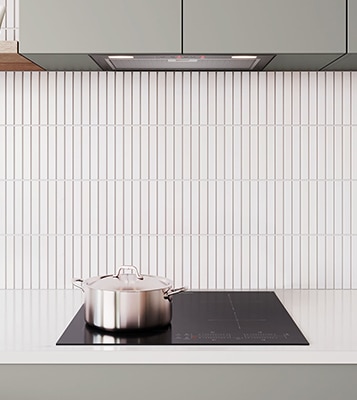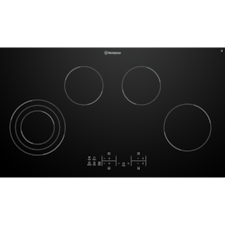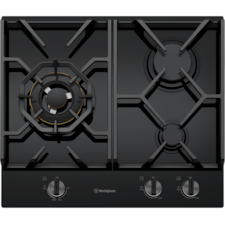1. Sizing
Kitchen layout
When it comes to your kitchen design, the biggest question you will need to ask is "How do I want to cook?". In your next kitchen you will want to consider a few things to make sure your new appliances and space works more effectively for you and your family. Follow the below guide before selecting your appliances:
CONSIDER YOUR CABINETRY
When looking at your cabinetry you can look to positioning the cooktop in the bench above your oven, which you would be used to seeing in most homes. If you are looking for a more contemporary kitchen design you may look to having your cooktop separate from your oven, with your oven being placed above bench height within your cabinetry.
KITCHEN TRIANGLE OR WORK ZONES
The way you configure your kitchen layout will ultimately come down to how big your space is. In the past, kitchen designers have spoken to the work triangle which has you drawing a line between the refrigerator, cooking appliances, and sink/dishwasher which creates a triangle that has you being able to move more efficiently in the space. The more recent way of working has kitchen designers breaking the space up into 5 zones : consumables, non-consumables, cleaning, preparation and cooking zones, allowing each space to work together.
PURPOSE OF YOUR ISLAND BENCH
Over recent years, there have been kitchens designed around the island bench becoming the work bench, the place you prepare, cook and clean with ovens, cooktops or microwaves being incorporated into their design. Previous kitchen design trends saw sinks being the most common element found in a kitchen island with a dishwasher beside it. Island benches have a range of ways they can be used, the key is designing to suit your lifestyle and how you will be using your kitchen.
Size of Cooktop
When researching for a new cooktop, it’s important to consider all elements of its size. You need to consider not only the width of the cooktop but also the number of different cooking zones it offers and whether they have flexibility.

60cm

90cm

90cm
The standard cooktop size is 60cm, enough for most households, however some brands offer cooktops as small as 30cm, slightly bigger at 70cm and the largest being 90cm. You may look at pairing a 30cm gas or induction cooktop with a 60cm cooktop of a different type, giving you ultimate flexibility in the kitchen.
When looking at cooking zones it is common to have 4, however you may also find the below combinations:
- 3 zones – 2 smaller and 1 large
- 4 zones of varying sizes with 1 having adjustable sizing between small and large
- 5 cooking zones – 4 cooking zones with a wok burner
2. Cooktop Type

Gas cooktops
- More common than induction cooktops.
- Easy install if there is presence of a gas connection.
- Specialty cookware not needed.
- The cook is in control and can intuitively control the heat, reacting to flame size - ideal for wok cooking.
- More ventilation required due to heat from open flame.
- Durable - with trivets they are more robust than their glass or ceramic counterparts.

Induction Cooktops
- Provide more precise temperature control with even heat distribution.
- Safer than other cooktops as the pot or pan is the object holding the residual heat not the cooktop surface and there is no open flame.
- Instant control and programmable features ie; pause, timer with auto-off programming.
- Flexibility - selected induction cooktops have adjustable cooking zones, pairing them together for larger pots and pans.
- Highly energy and time efficient because very little heat energy escapes - unlike with gas.
- More expensive initial outlay than other cooktops; however will cost less over their lifetime.
- Easy to clean with the a flat surface.
- Seamless design integration.
3. Type Of Cooktops

Induction cooktops
Whilst not currently the most chosen cooktop type, Induction cooking popularity continues to rise with it being integrated into most modern kitchen designs. With its precision in temperature control and overall efficient performance induction cooking in a lot of ways comes out on top.
Ideal for
- Small family - large family
- Apartment living
- Rental properties
No more boiling over
BoilProtect* detects rising bubbles via vibration sensors and automatically reduces your boiling water to a low simmer. No more constant monitoring, allowing you to focus on other elements of your dish.
*Applies to stainless steel and enamelled pots filled with water only.
Hands-free convenience
FlexZone - giving you room to move
Clean and sleek with precise control
Boiling or high heat in no time
Safety first

Ceramic Cooktops
Whilst there is common misconception that an induction or ceramic cooktop are the same, their similarities are limited to a similar finish and features. You will find that they generally take longer to reach desired heat and the reaction time isn't as instant.
Ideal for
- Medium Family
- Rental Property
Safety first
Quick-Cook Timer for ultimate control
Easy to clean
Touch control
Flexibility with Triple Zone
Pause when you need to

Gas Cooktops
Providing rapid and powerful heat, gas cooktops are popular amongst cooking enthusiasts and more traditional homes. Coming with electric ignition, you are able to start cooking within moments. A great advantage of cooking with gas is a clear visualisation of the heat via the bare flame.
Ideal for:
- Family
- Entertainer
- Serious Home Cook
Use high heat for flavourful dishes
Family safety first
Take control quickly
Flame out. Gas off.

Electric Cooktops
An electric cooktop is the most sensible choice of cooktop if you have a small budget. Though they come with basic features and may take longer than others to reach your chosen heat, they come with durable and corrosion-resistant surfaces.
Ideal for:
- Rental property
- First home
Durable and reliable
Easy temperature control
Big or small, you're covered

Westighouse induction cooktops
Our range of cooktops combines stylish good looks with practical features to help you cook with ease and confidence.

Bridge zone gives you room to move
Even the biggest pots and pans can be catered for with Bridge Zone. Designed with busy family kitchens in mind, Bridge Zone lets you use two induction zones separately or link them together when you're cooking for a crowd.

Westinghouse induction cooktops | BoilProtect
There are more exciting things to do than watching water boil. BoilProtect detects rising bubbles and automatically reduces to a low simmer. No more constant monitoring so you can focus on the flavours. Applies to stainless steel and enamelled pots filled with water only.

Westinghouse induction cooktops | Hob2Hood
With Hob2Hood technology, compatible rangehoods work seamlessly with your induction cooktop to clear your kitchen of cooking smells and steam. As you start cooking, the rangehood will automatically turn on then intuitively adjust the fan speed and airflow to match your cooking. How's that for hands-free convenience?

Westinghouse induction cooktops | Pause
We know that family life is full of distractions. That's why you'll appreciate our clever Pause function. Simply touch the Pause icon on your cooktop and all operating induction zones will drop to Keep Warm mode. When you're ready to go again, hit Pause again and settings will return to where you left off.

Westinghouse gas cooktops
Our range of gas cooktops is designed to look good and cook great with practical design features, now you can make every meal a winner. With fast heating and our Dual Valve technology, you can go from boil to simmer in no time at all.

Dual valve flame control for instant adjustment
For precision control cooking all your favourite recipes, our smart Dual Valve flame control lets you go from boil to simmer in an instant.

Westinghouse gas cooktops | Flat surface and safe design
For extra peace of mind, our flat trivets are designed to cover the large flat surface area for better pot stability.
4. Design & Other Considerations
INSTALLATION COSTS
Something to consider with any appliance purchase is installation costs or kitchen adjustments that need to be done to fit the appliance. When looking at a Gas Cooktop you will need to ensure you have a gas connection and whether your connection is natural or LPG ensuring the cooktop you choose is compatible. If you are leaning toward induction cooking in your kitchen you will need to assess whether you have enough amps to power an induction cooktop.
NEW COOKWARE INVESTMENT
Most modern cookware is induction friendly, however, there are still a lot out there that are not. This may mean that you need to purchase new pots and pans. Before you do the mental calculations of the extra costs grab a magnet and see if the base of your pots and pans attracts the magnet, if they do you should be cooking with induction in no time.
One thing to note when upgrading your kitchen is, just as there are 52 shades of white, same goes for appliance finishes. For best results, buy your appliances from one brand to make sure everything is seamless.
5. Warranty & Service
WARRANTY
Subject to terms and conditions our cooktops come with 24 months warranty in Australia and New Zealand, following the date of purchase. Click here to view Terms and Conditions.SUPPORT & SERVICE
We have a Customer Care team available to assist you over the phone during week days, and a national network of experienced technicians and selected service agents. Offering a fixed price guarantee with no additional hidden labour costs, giving you peace of mind that your appliance is in good hands.









